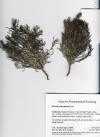|
Neokochia americana |
Kochia scoparia |
|
Neokochia californica (S. Watson 1882) G. L. Chu & S. C. Sanderson 2009 (“2008”). Mojave red sage. Subshrub to 60 cm, stems woody near base, mostly erect, covered with brown to gray hairs, branching regularly above base, branches ascending; leaves simple, fleshy, alternate, ±flattened, dark green, narrowly elliptic to sword- shaped, 5–10× longer than wide, to 20 mm long and 3.5 mm wide. Flowers May–Sep, small, apetalous, 2–5 in spherical clusters of leaf axils, each subtended by a scale-like bract on a short simple or branched scape, bisexual or unisexual; stamens 5; gynoecium 2-(3) carpelled with 2(-3) subulate stigmas; sepals 5, each expanded apically into broad horizontal veiny wing-like lobe in fruit, the fruit (gyroscopic diclesium) appearing more like a flower, enclosing the mature ovary (utricle). Of scattered occurrences in dry alkali lakes, San Joaquin Valley and Mojave Desert, Caifornia to southwestern Nevada. Type from western Nevada. Kern Co. Mojave Desert: “Rare on the subalkaline clay flats at Rosamond Dry Lake” (Twisselmann); Desert Wells (Purpus 1897, 1898); Indian Wells Valley, Lake Seep (Prigge 8 aug 1983); Mojave-Randsburg Region; Antelope Valley 60th Street at Avenue A, ~6 miles sw of Rosamond. San Joaquin Valley: Bakersfield (R. Rogers, 1897; Bauer, Sep 1928); Rio Bravo (Short & Johnson, Jun 1934). Occurring within the Suaeda nigra and Allenrolfea occidentalis alliances (MCV2) but not likely with Sarcobatus vermiculatus in Kern County. Difficult to grow from seed. The genus includes one other species, N. americana (S. Watson 1882) G. L. Chu & S. C. Sanderson 2009, distinguished by branching at base, subterete leaves, and by less hariy leaves; a decoction of the plant used by the Navajo for treataing veneral disease (Moerman). Suaeda nigra, also similar to K. californica, distinguished by the sepals not expanded in fruit and by the leaves appearing waxy ((glaucous).
Choi, J. K. T. Lee, H. Jung,: H. S. Park and H. J. Park. 2002. Anti-rheumatoid arthritis effect of the Kochia scoparia fruits and activity comparison of momordin lc, its prosapogenin and sapogenin. Arch. Pharm. Res. 25(3): 336–342. “MeOH extract of Kochia scoparia was fractionated into CHCl3-, EtOAc- and BuOH extracts and the last fraction were hydrolyzed by 3%-NaOH (MeOH-H2O) to compare the bioactivities on antinociceptive and anti-inflammatory effects. Silica gel column chromatography of BuOH fraction afforded a large amount of 3-O-beta-D-xylopyranosyl (1--)3)-beta-D-glucuronopyranosyl oleanolic acid (momordin lc, 4) and that of acid hydrolysate of BuOH fraction gave 3-O-beta-D-glucuronopyranosyl oleanolic acid (momordin lb, 3), its 6'-O-methyl ester (2) and oleanolic acid (1). Silica gel column chromatography of alkaline hydrolysate afforded a large amount of 4. MeOH extract and both EtOAc- and BuOH fractions were active in the rheumatoidal rat induced Freund's complete adjuvant reagent (FCA) whereas CHCl3 fraction was inactive. Compound 1 and 4 showed significant activities in the same assay but oleanolic acid 3-O-glucuronopyranoside (3) showed no activity. These fashions were also observed in carrageenan-induced edema of the rat and in the antinociceptive activity tests undertaken in hot plate- and writhing methods. These results suggest that momordin lc and its aglycone, oleanolic acid, could be active principles for rheumatoid arthritis.” Wang, H., C-L. Fan, B. Wang, Y. Dai, W-C. Ye and S-X. Zhao. 2003. Triterpene and saponins from Kochia scoparia. Chinese J. Nat. Med. 1 (3) 134–136. “Eight compounds were isolated from the fruits of Kochia scoparia [Bassia scoparia]: 3-0-β-D-xylopyranoyl (1->3)-β-D-glucuronopyranosyl oleanolic acid (1); 3-0-β-D-xylopyranoyl (1->3)-β-D-glucuronopyranosyl-28-β-D-glucopyranosyl oleanolic acid (2); 28-O-β-D-glucopyranosyl oleanolic acid (3); 3-O-[β-D-glucopyranosyl (1->2)-β-Dxylopyranosyl (1->3)]-β-D-glucuronopyranosyl oleanolic acid (4); 3-O-β-D-[6-O-methyl-glucuronopyranosyl] oleanolic acid (5); 3-O-β-D-xylopyranosyl (1->3)-[6-O-methyl-glucuropyranosyl] oleanolic acid (6); oleanolic acid (7); and stigmasterol 3-O-β-D-glycopyranoside (8). The structures of these compounds were determined by spectroscopic methods. Compounds 3, 5 and 8 were isolated from this plant for the first time.” |
|



